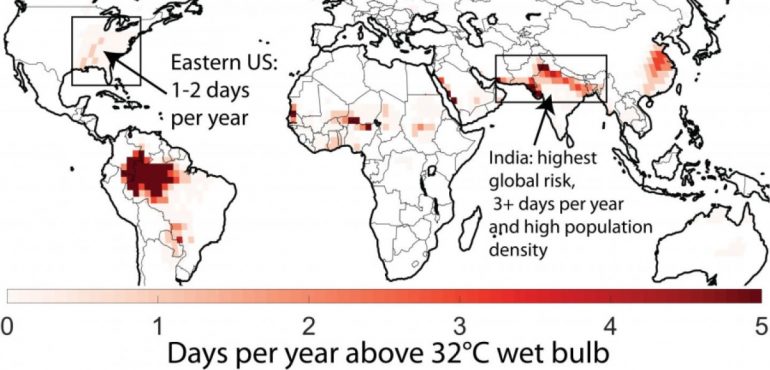Climate scientists say that killer heat waves will become increasingly prevalent in many regions as climate warms. However, most projections leave out a major factor that could worsen things: humidity, which can greatly magnify the effects of heat alone. Now, a new global study projects that in coming decades the effects of high humidity in many areas will dramatically increase. At times, they may surpass humans' ability to work or, in some cases, even survive. Health and economies would suffer, especially in regions where people work outside and have little access to air conditioning. Potentially affected regions include large swaths of the already muggy southeastern United States, the Amazon, western and central Africa, southern areas of the Mideast and Arabian peninsula, northern India and eastern China.
"The conditions we're talking about basically never occur now -- people in most places have never experienced them," said lead author Ethan Coffel, a graduate student at Columbia University's Lamont-Doherty Earth Observatory. "But they're projected to occur close to the end of the century." The study will appears this week in the journal Environmental Research Letters.
Warming climate is projected to make many now-dry areas dryer, in part by changing precipitation patterns. But by the same token, as global temperatures rise, the atmosphere can hold more water vapor. That means chronically humid areas located along coasts or otherwise hooked into humid-weather patterns may only get more so. And, as many people know, muggy heat is more oppressive than the "dry" kind. That is because humans and other mammals cool their bodies by sweating; sweat evaporates off the skin into the air, taking the excess heat with it. It works nicely in the desert. But when the air is already crowded with moisture -- think muggiest days of summer in the city -- evaporation off the skin slows down, and eventually becomes impossible. When this cooling process halts, one's core body temperature rises beyond the narrow tolerable range. Absent air conditioning, organs strain and then start to fail. The results are lethargy, sickness and, in the worst conditions, death.
Using global climate models, the researchers in the new study mapped current and projected future "wet bulb" temperatures, which reflect the combined effects of heat and humidity. (The measurement is made by draping a water-saturated cloth over the bulb of a conventional thermometer; it does not correspond directly to air temperature alone.) The study found that by the 2070s, high wet-bulb readings that now occur maybe only once a year could prevail 100 to 250 days of the year in some parts of the tropics. In the southeast United States, wet-bulb temperatures now sometimes reach an already oppressive 29 or 30 degrees Celsius; by the 2070s or 2080s, such weather could occur 25 to 40 days each year, say the researchers.
Lab experiments have shown wet-bulb readings of 32 degrees Celsius are the threshold beyond which many people would have trouble carrying out normal activities outside. This level is rarely reached anywhere today. But the study projects that by the 2070s or 2080s the mark could be reached one or two days a year in the U.S. southeast, and three to five days in parts of South America, Africa, India and China. Worldwide, hundreds of millions of people would suffer. The hardest-hit area in terms of human impact, the researchers say, will probably be densely populated northeastern India.
"Lots of people would crumble well before you reach wet-bulb temperatures of 32 C, or anything close," said coauthor Radley Horton, a climate scientist at Lamont-Doherty. "They'd run into terrible problems." Horton said the results could be "transformative" for all areas of human endeavor -- "economy, agriculture, military, recreation."
The study projects that some parts of the southern Mideast and northern India may even sometimes hit 35 wet-bulb degrees Celsius by late century -- equal to the human skin temperature, and the theoretical limit at which people will die within hours without artificial cooling. Using a related combined heat/humidity measure, the so-called heat index, this would be the equivalent of nearly 170 degrees Fahrenheit of "dry" heat. But the heat index, invented in the 1970s to measure the "real feel" of moist summer weather, actually ends at 136; anything above that is literally off the chart. On the bright side, the paper says that if nations can substantially cut greenhouse-gas emissions in the next few decades, the worst effects could be avoided.
Only a few weather events like those projected have ever been recorded. Most recent was in Iran's Bandar Mahshahr, on July 31, 2015. The city of more than 100,000 sits along the Persian Gulf, where seawater can warm into the 90s Fahrenheit, and offshore winds blow moisture onto land. On that day, the "dry" air temperature alone was 115 degrees Fahrenheit; saturated with moisture, the air's wet bulb reading neared the 35 C fatal limit, translating to a heat index of 165 Fahrenheit.
Bandar Mahshahr's infrastructure is good and electricity cheap, so residents reported adapting by staying in air-conditioned buildings and vehicles, and showering after brief ventures outside. But this may not be an option in other vulnerable places, where many people don't have middle-class luxuries.
"It's not just about the heat, or the number of people. It's about how many people are poor, how many are old, who has to go outside to work, who has air conditioning," said study coauthor Alex deSherbinin of Columbia's Center for International Earth Science Information Network. De Sherbinin said that even if the weather does not kill people outright or stop all activity, the necessity of working on farms or in other outdoor pursuits in such conditions can bring chronic kidney problems and other damaging health effects. "Obviously, the tropics will suffer the greatest," he said. Questions of how human infrastructure or natural ecosystems might be affected are almost completely unexplored, he said.
Only a handful of previous studies have looked at the humidity issue in relation to climate change. It was in 2010 that a paper in the Proceedings of the National Academy of Sciences proposed the 35-degree survivability limit. In 2015, researchers published a paper in the journal Nature Climate Change that mapped areas in the southern Mideast and Persian Gulf regions as vulnerable to extreme conditions. There was another this year in the journal Science Advances, zeroing in on the densely populated, low-lying Ganges and Indus river basins. The new study builds on this earlier research, extending the projections globally using a variety of climate models and taking into account future population growth.
Elfatih Eltahir, a professor of hydrology and climate at the Massachusetts Institute of Technology who has studied the issue in the Mideast and Asia, said the new study "is an important paper which emphasizes the need to consider both temperature and humidity in defining heat stress."
Climate scientist Steven Sherwood of the University of New South Wales, who proposed the 35-degree survivability limit, said he was skeptical that this threshold could be reached as soon as the researchers say. Regardless, he said, "the basic point stands." Unless greenhouse emissions are cut, "we move toward a world where heat stress is a vastly greater problem than it has been in the rest of human history. The effects will fall hardest on hot and humid regions."
The Earth Institute at Columbia University. (2017, December 22). Humidity may prove breaking point for some areas as temperatures rise, says study: From US south to China, heat stress could exceed human endurance. ScienceDaily. Retrieved December 22, 2017 from www.sciencedaily.com/releases/2017/12/171222090302.htm






